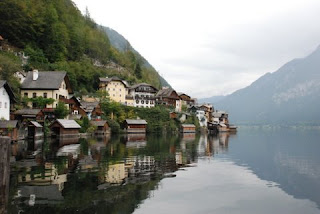



It's 'Grosser Almabtrieb mit Dorffest' in Zell am Ziller – in other words, it is a festival to celebrate the bringing down of the cows from the high pasture. This is a tradition in many Alpine areas and the cows wear elaborate headdresses as they parade through the town.
We had been told that the route of the cows took them past the campsite but the first herd, earlier than expected at 09:30 took another route. I wanted to photograph them on the outskirts of the town before they reached the crowded centre and so we walked a few hundred metres out of town from the campsite. Nothing happened and we couldn't find anyone who knew when the next herd would arrive. We walked into town and found the crowds of people from the many coaches, mainly German, that we had seen pouring in. Here a Zell am Ziller band of three brothers called Zellberg Buam was performing. Their 'Fanshop' was seething and middle-aged and older fans were buying CDs, stickers, T-shirts etc. and queuing to have them signed by the brothers. Given that most of the visitors were German and the band hadn't even started playing yet, we concluded that the band must be very well known outside the area and outside Austria. We resisted the temptation to buy any of their goods even though they were very good. It was the kind of music that sounded good in the country but we would not have played it when we got home. There were also a number of craft stalls to see such as a talented woodcarver, a basket maker and a still producing schnapps.
Just before midday I decided to walk up the road to the campsite and came across the next herd. Most of these herds come from the area of the Gerlos pass where there is access to the Summer pastures and this road is the obvious access to the town. In past times, the cows would have been decorated using fresh flowers but these days plastic flowers and tinsel predominate. We were both surprised at how religious the parade was – almost every cow had either a religious message or a painting of Jesus, Mary or one of the saints.
Having taken some photographs, I moved on to the bottom of the Gerlos road before it entered the tow. I had a short wait but then, announced by the Fire Station siren, a number of herds came down the road. I followed them into town to the crowded centre somewhat disturbed by the state of the roads and pavements. In such a tidy country as Austria, how could they allow the cows to cover the asphalt in cow-shit? And there was the aroma or should I say stink? The Austrians shouldn't allow it but then farming, and especially dairy farming, is so much part of life here.
We continued listening to Zellberg Buam and watched the dancers who were excellent. Herds of cows continued to pass through and after a beer and bratwurst with mustard, we followed one of the passing herds. They crossed the river and walked up beside the river. Here we came across another stage with a local band playing, although they were not as good as Zellberg Buam. We returned to the campsite but herds continued to pass until late in the afternoon.
Photos: The woodcarver producing a typical carving of a forest man; The cows didn't respect the fact that pavements are for pedestrians and it was often necessary to take avoiding action; The cowherds struggled to keep the cows in check on the hill – they had been doing this for the 17 kilometres from Gerlos; The cows round the bend before entering Zell am Ziller.













































